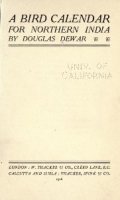Douglas Dewar presents a rich account of the bird life in April in his classic A Bird Calendar for Northern India, published in 1916. Here are a few extracts:
| In the eastern and southern districts hot-weather conditions are established long before mid-April, while in the sub-Himalayan belt the temperature remains sufficiently low throughout the month to permit human beings to derive some physical enjoyment from existence. In that favoured tract the nights are usually clear and cool, so that it is very pleasant to sleep outside beneath the starry canopy of the heavens. As soon as the Holi festival is over the cultivators issue forth in thousands, armed with sickles, and begin to reap. They are almost as active as the birds, but their activity is forced and not spontaneous…Many trees are in flower. Throughout April the air is heavy with the scent of blossoms.The great avian emigration, which began in March, now reaches its height. During the warm April nights millions of birds leave the plains of India. The few geese remaining at the close of March, depart in the first days of April.The brahminy ducks*, which during the winter months were scattered in twos and threes over the lakes and rivers of Northern India, collect into flocks that migrate, one by one, to cooler climes, so that, by the end of the first week in May, the a-onk of these birds is no longer heard. The mallard, gadwall, widgeon, pintail, the various species of pochard and the common teal are rapidly disappearing. With April duck-shooting ends. Of the migratory species only a few shovellers and garganey teal tarry till May.
The snipe and the quail are likewise flighting towards their breeding grounds. Thus on the 1st of May the avian population of India is less by many millions than it was at the beginning of April. But the birds that remain behind more than compensate us, by their great activity, for the loss of those that have departed. There is more to interest the ornithologist in April than there was in January. The bird chorus is now at its best. In the hills the woods resound with the cheerful double note of the European cuckoo# (Cuculus canorus). This bird is occasionally heard in the plains of the Punjab in April, and again from July to September, when it no longer calls in the Himalayas. This fact, coupled with the records of the presence of the European cuckoo in Central India in June and July, lends support to the theory that the birds which enliven the Himalayas in spring go south in July and winter in the Central Provinces. Ornithologists stationed in Central India will render a service to science if they keep a sharp look-out for European cuckoos and record the results of their observations. In this way alone can the above theory be proved or disproved. April is a month in which the pulse of bird life beats very vigorously in India. |
* Also called: Ruddy Shelduck.
# Also called: Eurasian Cuckoo.
Taken, with grateful thanks, from Project Gutenberg.

